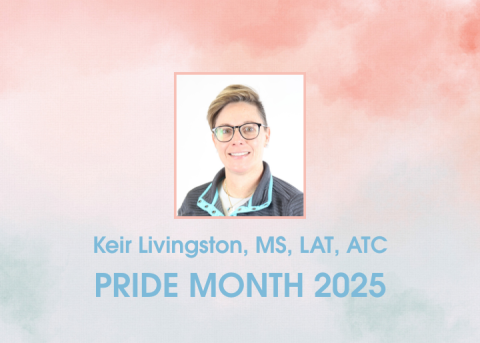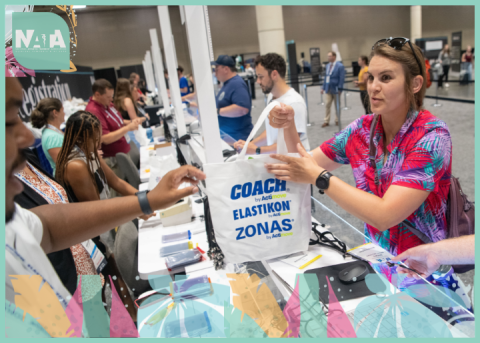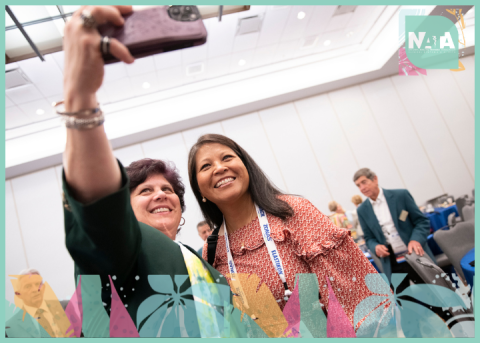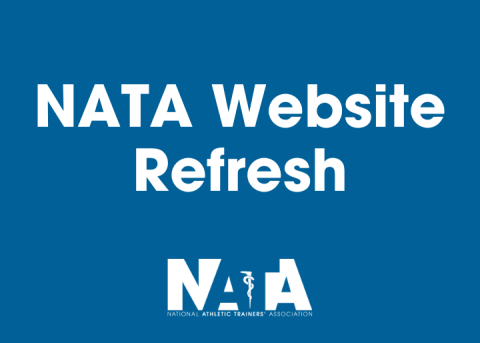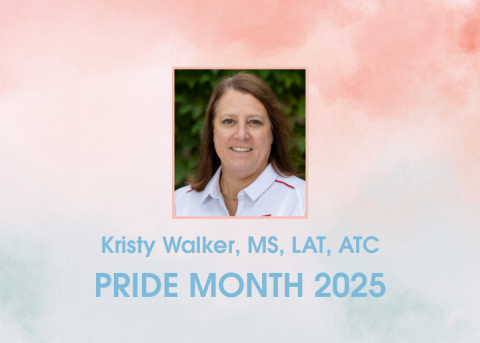
The May NATA News includes profiles on the seven members who will be inducted into the NATA Hall of Fame during the 70th NATA Clinical Symposia & AT Expo this June in Las Vegas. Take a walk down memory lane with these inductees as they share their most memorable career moments and the best advice they received.
For more wise words from this year’s award winners, follow #NATAinspirATion on social media throughout May.
What’s your most memorable moment in the profession?
Pat Aronson, PhD, LAT, LPTA, ATC: There are so many; it is difficult to nail down the most memorable. My students will tell you that I teach by telling stories. I remember many great, and frustrating, moments being an AT. I have enjoyed game day as well as graduation day. Seeing student athletes who have been my patients and AT students who I have taught and mentored excel makes for great memories. I feel that way about young professionals also. Watching young ATs excel makes for great memories.
David Csillan, MS, LAT, ATC: The rewarding thing about this profession is that it leaves so many great moments. In a nutshell, Dr. Seuss referred to the places you’ll go, the things you will see, the people you’ll meet and the things you will do. Yes, I remember them all. However, there is one that sticks out above all others. Early in my career, I was working a soccer camp in mid-summer when a soccer player came to the medical tent with red blood leaking from the nose. He, nor others around him, could recall any major physical contact to the face. The session ended and the player returned to his dorm. Thirty minutes later, a coach returned with the player. His pupils were fixed, he wasn’t communicating well and the trickle of red blood turned to an orange tinge and then clear. Along with another athletic trainer, we kept the player stabile while continuously monitoring vital signs until EMS arrived. The trauma center’s diagnosis was a basil skull fracture and commended us for recognizing of cerebral spinal fluid and urging prompt medical attention. It was that moment when I understood that athletic trainers do more than tape ankles. We save lives.
Christopher D. Ingersoll, PhD, AT, ATC, FACSM, FNATA, FASAHP: There are too many memorable moments to pick one. Every time I was able to help someone achieve their goals was memorable to me, particularly when it was one of my students.
Timothy L. Neal, MS, AT, ATC, CCISM: I think the memorable moments are in different areas. In terms of direct care, it would be working alongside athletic training staff and physicians in saving the life of Conference USA official Gerry Bram, who suffered sudden cardiac arrest during the Sept. 29, 2001, East Carolina-Syracuse University football game. AEDs were just gaining momentum in sports medicine in the early 2000s, and that emergency with Bram ran like a training session, except it was for keeps.
In the area of scholarship and collaboration, serving as the chair of the NATA Committee on Professional Ethics and working with so many outstanding athletic training professionals in furthering ethical practice has been so rewarding. One of the growing concerns in health care is mental health and wellness, and that athletes are not immune from mental health disorders. Chairing two NATA Inter-Association Consensus Statements on developing plans to recognize and refer student athletes with psychological concerns (2013 was a collegiate focus, 2015 for secondary schools) has furthered the awareness of psychological issues that athletic trainers need to take into account when caring for athletes and in becoming the point person in recognition and referral into mental health care. My participation with ATs Care has meant so much to me. Being trained in critical incident stress management and assisting fellow athletic trainers during their time of need following a critical incident has been a career highlight. Being a member of the NATA Professional Responsibility in Athletic Training Committee and assisting NATA members to better understand the legal, ethical and regulatory issues in their practice is changing the way athletic trainers view their professional responsibilities. Finally, I believe I have more to contribute to the profession in the coming years and look forward to more memorable moments collaborating with other athletic trainers to advance our profession.
Gretchen Ann Schlabach, PhD, ATC: Two moments had equal memorable weight. The first extraordinary moment was when the NATA Board of Directors voted to approve the creation of the inaugural NATA Women in Athletic Training Task Force, which later became a committee in the mid-1990s. It was so exciting to serve alongside pioneer women, who were making a difference by advancing important issues, such as women in leadership and service, as well as, life-balance concerns. The second most unforgettable moment was when the NATA BOD approved the inaugural NATA Professional Responsibility in Athletic Training task force that became a stand-alone committee in 2016. It’s been remarkable serving with this dedicated group, who is moving the needle relative to advancing legal, ethical and regulatory issues in athletic training.
Scott Ray Sailor, EdD, ATC: The most memorable moment for me occurred when all the members of the Strategic Alliance had spent nearly two years investigating and discussing moving professional education to the master’s degree level. The discussions were intense and the work was extensive. There had been open forums at every district meeting, experts were asked to give their opinions, every NATA committee was asked to examine the issue through their lenses and a lot of dialogue was exchanged between the leadership of the Strategic Alliance. Each entity of the alliance eventually voted independently of each other. Once those votes were cast, the presidents and executive directors met outside a meeting room to report to one another how their boards had voted. As president-elect, I was tagging along with, then, President Jim Thornton, MA, ATC, CES. All four boards voted to make the transition. It dawned on me, at that point, that none of these volunteer leaders currently had master’s level professional programs. Each presidents was going to have to undergo transitioning their own programs since this decision had been made. It would have been easier for each of them to decide against this change, but they were not people who were thinking about their own situation. They wanted to do what was best for the long-term health of this profession. That was amazing to witness.
Charles Vosler, AT Ret.: Until I received the telephone call that I had been elected into the NATA Hall of Fame, the most memorable moment was when the Ohio University College of Health Science and Professions informed me it was dedicating the new “Charles ‘Skip’ Vosler Athletic Training Educational Facility” in my name. During the dedication, it was noted that my career illustrated dedication, intensity, passion and had an educational impact in the college. They concluded that this was a fitting tribute to honor a pioneer and leader whose vision literally set the course in athletic training education and the athletic training profession.
What’s the most valuable advice you have received during your career?
Pat Aronson, PhD, LAT, LPTA, ATC: The most valuable advice I received in my career was given to me by my boss who told me, “You must take one day off per week.” When I did, it made a great difference in my quality of life, but also in the quality of my work.
David Csillan, MS, LAT, ATC: From the late ’80s to early ’90s, I was employed in an orthopedic practice. One morning, senior physician Dr. David Smith summoned me to his office. I prepared myself for the worst, but heard the best. Smith detailed why health care providers must have excellent bedside manner. “Patients don’t care how much you know, they want to know how much you care,” he said. In my 33 years of practicing athletic training, I’ve found this mantra guiding me to positive outcomes with my athletes.
Christopher D. Ingersoll, PhD, AT, ATC, FACSM, FNATA, FASAHP: “Read not to contradict and refute, nor to accept and take for granted, but to weigh and consider.” Sir Francis Bacon by way of Ken Knight
Timothy L. Neal, MS, AT, ATC, CCISM: The best advice I ever received is that athletic trainers do not just treat injuries; athletic trainers care for people. Everything we do as health care professionals is to provide holistic care to the patient, athlete or client; become focused and committed to providing care at a high level at all times.
Gretchen Ann Schlabach, PhD, ATC: Early in my career, it was suggested that I find the courage to get out of your comfort zone and explore innovative possibilities and opportunities. I treasure the experiences that I had on the East Coast, in the Deep South and in the Midwest, as well as my different roles as an athletic trainer (clinician, scholar, educator, program director). I have come to appreciate and value differences and similarities. I believe those experiences helped me grow personally and professionally.
Scott Ray Sailor, EdD, ATC: Early upon my return to Fresno State, I worked with and athletic director named Gary Cunningham. I heard Gary share his leadership philosophy with the athletic department staff at one point. He said his job was to make sure we had the resources and support we needed to be successful. If we were all successful in our positions then he would be viewed as successful. I adopted that philosophy at that point and still use it today. My biggest joy is helping others achieve their own success. Isn’t that often what athletic training is all about after all?
Charles Vosler, AT Ret.: The best advice I received was, “Do not follow your heart, but follow your educational instincts/principles.” This applies to the immediate response to athletic injuries, rehabilitation and teacher education. Coach Woody Hayes once told me to have high expectations, be demanding with valid principles and show love for your mankind. I have used this advice throughout my career. Recruited athletic training students and their parents, they are advised of my expectations in their education, maintaining a 3.0 GPA. They are all made aware that if accepted they will be in highly discipline structure program including daily responsibilities, study table and daily/weekly assignments in athletic training rooms. During my 27-year tenure at Ohio University, 600-plus students graduated. None of these had less than a 3.3 accumulative for four years. Also, it is important to recognize that less than five who have taken the certification/licensing exams did not pass. I am so proud that all have done very well in their chosen professions.

